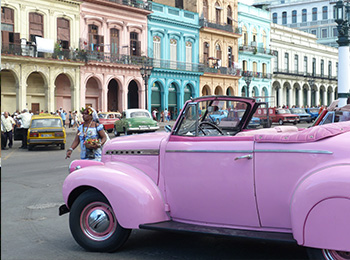After a two-hour drive through rural mountain villages in a decommissioned Russian army truck, we arrived at El Nicho conservation area, a nature lover’s dream with hiking trails and a panoramic backdrop of the Escambray mountains. We hiked a steep rugged trail, passing dozens of waterfalls. Anxious to cool off, we stopped to swim at the base of one, the water invitingly clear, aqua green , but I yelped at the surprisingly freezing temperature. On our way back, we stopped at a roadside fruit stand to buy several enormous local fruits called mamay that take 25 years to grow. Tearing them apart with our fingers, juices dripping down our faces, they tasted deliciously like a cross between a sweet potato and mango.
Tourists are a rare sight in the villages of rural Cuba. Locals ran out of their houses, waving, trying out their English, shouting the carefully enunciated “How are you?” The few vehicles were primarily horse drawn carts, farmers plowed fields with horses and I was surprised to see a number of cowboys on horseback.
I had arrived here by way of Cuba Cruise's Louis Cristal ship, which circumnavigates the island during the winter season and takes passengers places they wouldn’t normally visit. Most tourists go to the resort side of Cuba, approximately a 12-hour drive from Cienfuegos city centre where we had docked.
I had boarded the ship in Havana, after a tour of the city in a 1950 red and white Chevy convertible, one of 70,000 classic American cars that account for half of the vehicles on the island. After a couple of hours, we reluctantly left Lucito, our driver and his grandfather’s car and strolled around Old Town Havana. Wafts of Cohiba cigars followed us so it seemed natural when our guide took us to a cigar specialty store where we saw them rolling them by hand. I dearly wished I had more time there to explore the cafes, shops and see more of the faded elegant beauty of the historic buildings, but the ship was waiting.
Three days into the trip, we disembarked at Paradise Island for a nature and adventure tour. A catamaran took us around the Bay of Nipe, where we snorkeled in the clear, aquamarine water. Our guide, Alberto, pointed out a variety of urchins, and schools of brightly coloured fish. After lunch at an ocean-front restaurant, jeeps took us to Cayo Saetia, a natural reserve of pure white sand. A former place of leisure for the government, it’s now open to tourists and locals. The reserve is stocked with animals from Africa and China.
Two days later, we pulled into port at Montego Bay, Jamaica, docking shortly after 7 a.m. Eager to see the island, I stood on deck with my morning cup of tea. It wasn’t the black clouds, but the rainbow that caught my attention.
As I had never been to Jamaica before, I wanted to take full advantage so we went on a bamboo raft excursion for around three kilometres down a winding river. The seven-metre long, flat-topped rafts, used to carry bananas for export, became famous when Errol Flynn put a seat on the raft, for the comfort of his vacationing Hollywood friends. Birds were plentiful and we were lucky enough to see a swallow-tailed hummingbird, the national bird of Jamaica. At one point, our guide, Capt. Jeff made a paste from limestone out of the river, which he rubbed on my feet and legs. Just before we disembarked, he rinsed it off, leaving my skin silky soft and smooth. One of the guides, Romeo, sang Bob Marley’s Buffalo Soldier as we pulled into shore.
Back in the south part of Cuba, my travel companion and I hadn’t signed up for an excursion, so we explored the city of Santiago de Cuba on our own.. A city map cost two pesos, and the helpful local vendor even circled landmarks to visit.
We headed for the beautiful spires we had seen from the ship, and found the Catedral de Santiago de Cuba, built on the central square in 1535, with its dramatic yet simple pulpit in marble and silver. We then combed the side streets for the Trova de Oro or Club 300 where the music movement of Cuba was first born. We were rewarded with the incredible voices of two older female singers, and fleet-footed salsa dancers sweeping through the closet-sized club.
We both enjoyed the sociable aspect of the cruise and dining with six strangers every evening insured that we met people from all over the world, including a 93-year-old grandfather who was delighted when we took him snorkeling for the first time.
Every day there were many excursions available but as most ports are close to city centres, you can explore them on your own. Exchange some dollars for Cuban pesos, and you can take a local taxi, and design your own tour, but do discuss the fare before you set out.
Would I recommend the cruise? Absolutely. It shows an authentic view of Cuba, that is likely to soon disappear, a place where farmers wave from their horses as they plow the fields – wanting only a smile or a wave in return.
For more information: www.yourcubacruise.com. To read more of Melody’s travel adventures, visit her website: www.melodywren.com
